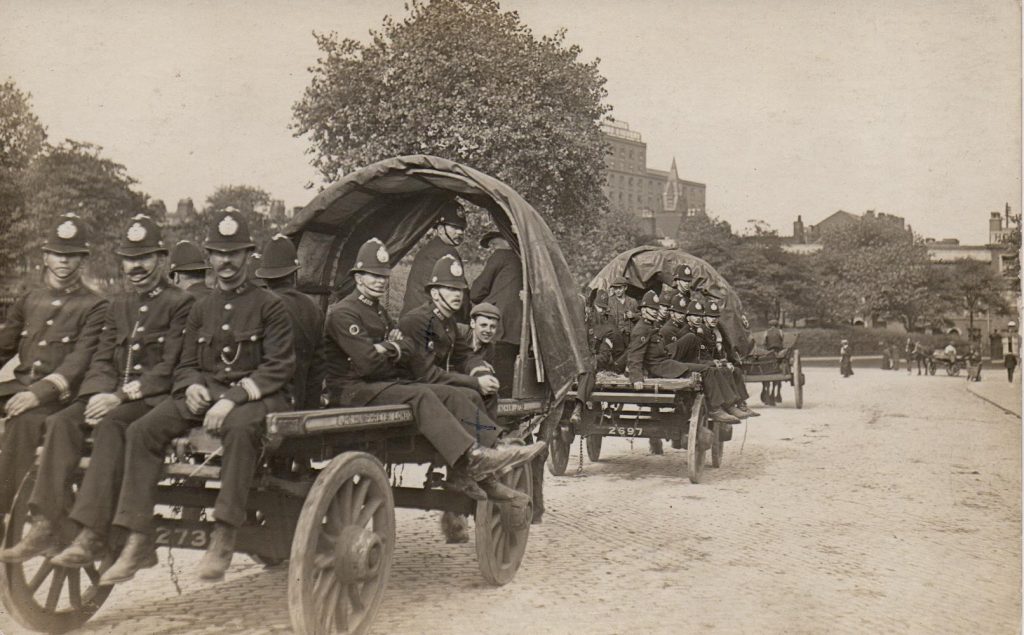In 1918, officers of both the Metropolitan Police and City of London Police marched to Downing Street. They protested about poor pay and working conditions, as well as the victimisation of members of the national policing union.
John Syme created the National Union of Police and Prison Officers (NUPPO) in 1913. A former inspector in the Metropolitan Police, he left following disagreements with senior officers that saw him moved to another division. He thought it was unjust, so he started start a campaign against those officers. He went to prison several times, and the union eventually split with him.
The height of the strike came in the summer of 1918. The Union Executive consisting of:
- PC Tommy Thiel (his dismissal arguably became the catalyst for the strike)
- chairman PC James Marston
- honorary secretary PC John Crisp
- City of London PC John Zollner
Met with Prime Minster David Lloyd George and other officials to agree terms to get the officers back to work. Most of their demands were met, including:
- higher pay
- pensions for widows
- child allowances
- PC Thiel reinstated
However, their request for the Prime Minister to recognise their union did not get agreed. This would be a point of disagreement in the future, as they thought Lloyd George would do so once World War I ended. Lloyd George though stated he never agreed to this.

NUPPO gained numbers across the country throughout 1918 and into 1919. Apparently, the Birmingham City Police became the biggest branch outside London. This caused problems for the Chief Constable, Charles Haughton Rafter.
In the spring of 1919, the government created the Desborough Committee. It would formally look into the pay and working conditions of police forces across the country.
In May 1919, with a pay increase still pending, and no formal recognition from the government, NUPPO asked its members whether it wanted to strike. The result of the ballot was no, which was fortunate for the government. It then rushed through the recommendations of the Desborough Committee in the Police Act 1919. It gave officers much better pay and working conditions, however, it crucially made it illegal for police officers to go on strike.
July 1919 saw a further ballot took place, with a strike called on 31 July. It was much different then the previous one. Officers in:
- Birmingham
- Bootle
- Birkenhead
- Liverpool
- Wallasey
All joined their London colleagues. The numbers were much smaller, as many officers, including half the NUPPO Executive, did not join. Some even snuck back on duty after seeing how unsuccessful the strike was. Under 2,500 officers took part and all of them, bar those that went on strike in Liverpool, were dismissed.
Despite pleas, petitions and appeals, none of the other officers were reinstated. It took a change in pension regulations in 1926 for them to get their pension contributions back.
Many people believed none of the officers ever wore a uniform again. As part of a new book that you can buy though, research shows that two Birmingham officers did return to policing. Frederick Hussellbee became a first police reserve, likely in Staffordshire Police, while Frank Howes became a special constable.
Out of the Blue tells the amazing story of the events of the strikes in 1918 and 1919. It explains why over 2000 officers risked everything to fight for a cause that many assumed won. You’ll also learn what happened to most of the Birmingham officers when they left the force.
The book also has incredible personal stories, including that of NUPPO Birmingham Branch Chair Edward Charles Taylor, who had only months left before retirement.
West Midlands Police Chief Constable Sir David Thompson said the book is the “definitive record of the police strike.” We’ve captured and published more information than previous publications have been able to.
Buy Out of the Blue on the website, or come and buy it from the museum.
